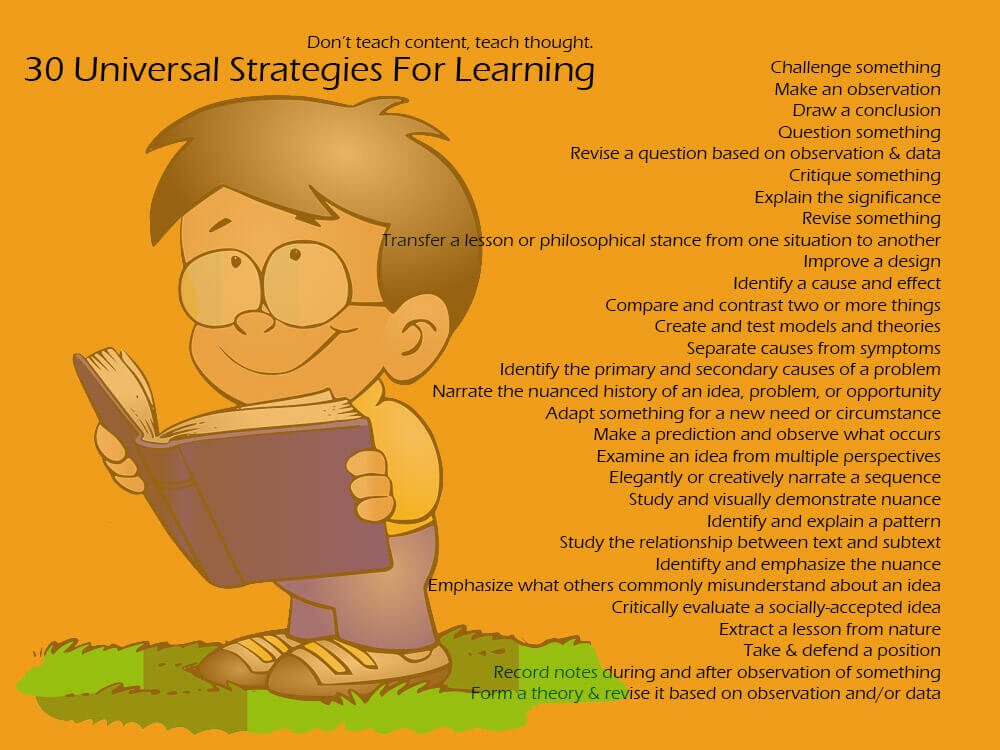
30 Universal Strategies For Critical Learning
by Terry Heick
As teachers, we’re all trying to better understand how people learn–not now they’re taught in terms of teaching strategies, but more so learning strategies–only not really strategies. Learning actions, or cognitive actions. Strategies for learning.
Self-directed and social learning will undoubtedly be at the core of any sort of future learning and the idea of critical literacy and critical learning in pursuit of that literacy are central to a modern education.
But to improve learning in both self-directed and teacher-centered learning environments, it can be illuminating to look past the activities, projects, and courses to try to see what sort of brain-level actions learners are performing. Like push-ups, wind sprints, and weight training are physical actions that help train an athlete’s body, what kind of cognitive actions train a learner’s mind?
Bloom’s taxonomy–especially the annotated ‘Bloom’s Wheel’–helpfully offers Bloom’s Taxonomy verbs that drive the planning of learning activities, but I wanted to be even more specific. The goal here is to create a self-directed learning model that supports 21st-century learners in finding, analyzing, improving, repackaging, and sharing data in pursuit of self-knowledge. But pushed further, what are those specific strategies that work universally?
In the TeachThought Learning Taxonomy, we approached this idea and did so again with How To Add Rigor To Anything. And 32 Habits That Make Thinkers. This is another attempt to understand.
Using ‘Universal Learning Strategies’
So how can this help you as an educator? Use them as thinking prompts or discussion cues. Consider them as starting points for project-based learning. Have students use them as ’empty vessels’ to fill with self-selected learning topics to create learning paths of their own. Use them for Genius Hour.
The big idea is that these kinds of ‘brain actions’ are not only the kinds of tasks you can use to create assignments but more importantly, are the kinds of acts that promote inquiry-based understanding. So rather than start with a topic–fractions, gravity, metaphors, or racism–you can simply insist on the cognitive action itself. Learners can choose topics of their own, or you can offer a range of topics.
An example? Learners are given this list, and ask to provide a topic they’re curious about. They choose an ‘action’ that makes sense of their topic, then asked to come up with an assignment, project, or simply activity that is authentic. If they have trouble, offer them three choices that align with your curriculum or given academic standards. A Social Studies teacher might offer push-pull factors, industrialism, and factors in social change. For social change, 2, 4, 11, and 16 all make perfect sense.
Individually, in small groups, or in a dialogue with you, students begin to create their own assignments, and you transition from task-master to learning facilitator. In and of themselves, they’re not ‘ready-made’ assignments, but they’re not supposed to be. They’re meant not to build content capacity, but learning capacity. Ideally, they’d be part of a larger self-directed learning model–a simplified version of which I’m working on as well.
30 Universal Strategies For Critical Learning
- Challenge a perspective, social norm, accepted truth, or commonly-held notion
- Make an observation
- Draw a conclusion
- Question something
- Revise a question based on observation & data
- Critique something
- Explain the significance
- Revise something
- Transfer a lesson or philosophical stance from one situation to another
- Protect or restore something
- Identify and separate cause and effect
- Compare and contrast two or more things
- Create and test models and theories
- Separate causes from symptoms
- Identify the primary and secondary causes of a problem
- Narrate the nuanced history of a concept, theory, idea, problem, or opportunity
- Adapt something for a new need or circumstance
- Make a prediction and observe what occurs
- Examine an idea from multiple perspectives
- Narrate a sequence or change over time
- Study and visually demonstrate nuance
- Identify and explain a pattern
- Identify and prioritize ‘things’ by some theme, criteria, or standard.
- Elegantly emphasize origins, sources, influences, legacies, and traditions
- Emphasize what others commonly misunderstand about an idea
- Critically evaluate a socially-accepted idea
- Extract a lesson from nature
- Take & defend a position
- Record notes during and after observation of something
- Form a theory & revise it based on observation and/or data

